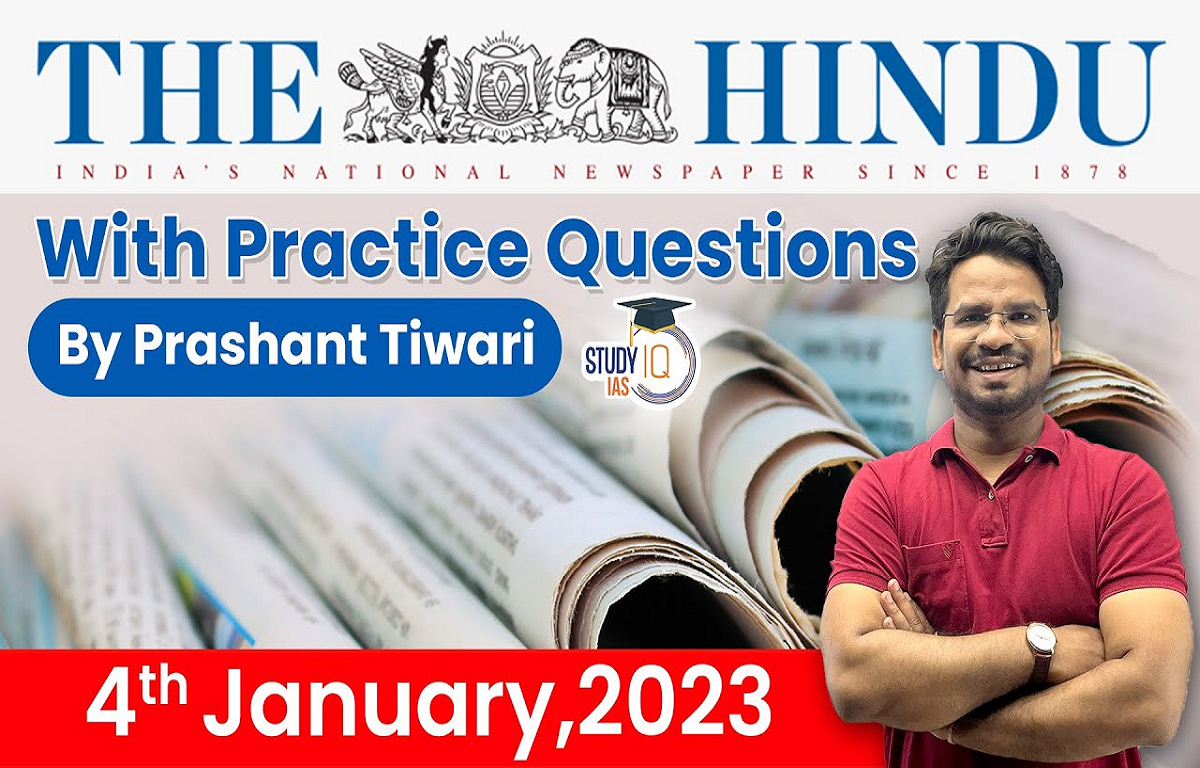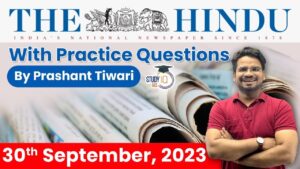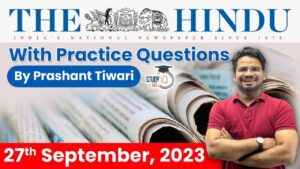The Hindu Newspaper Analysis for UPSC

The Hindu Newspaper Analysis 3 January 2023
- The Supreme Court held on Tuesday that there is no reason to impose “additional restrictions” on the right to free speech of Ministers, and the government is not vicariously liable for disparaging remarks made by them, even if the comments are traceable to state affairs or meant to protect the government.
- “A statement by a Minister, even if traceable to any affairs of the state or for protecting the government, cannot be attributed vicariously to the government by invoking the principle of collective responsibility,” Justice V. Ramasubramanian held in the main judgment of the Constitution Bench. The judgment was endorsed by Justices S. Abdul Nazeer, B.R. Gavai and A.S. Bopanna on the Bench.
- “It is not possible to extend this concept of collective responsibility to any and every statement orally made by a Minister outside the House of the People/Legislative Assembly… The Prime Minister or the Chief Minister does not have disciplinary control over the members of the Council of Ministers… in a country like ours, where there is a multi-party system and where coalition governments are often formed, it is not possible at all times for a Prime Minister/Chief Minister to take the whip whenever a statement is made by someone in the Council of Ministers,” Justice Ramasubramanian observed.
- It said the right of free speech and expression, guaranteed under Article 19 (1) (a), cannot be curbed by any additional grounds other than those already laid down in Article 19 (2).
The Hindu Editorial Today
Reasonable Restrictions
- Sovereignty and integrity of India
- Security of the state
- Friendly relations with foreign states
- Public order
- Decency or morality
- Contempt of court
- Defamation and
- Incitement to an offence

- Soon, a Constitution Bench of the Supreme Court of India will deliver its verdict on the validity of Tamil Nadu’s law permitting the practice of jallikattu in the State. Usually held during the Pongal season, jallikattu is a sport where men compete against each other to hold on to the humps of agitated bulls that are released into an open arena.
- In 2014, in Animal Welfare Board of India v. A. Nagaraja, a two-judge Bench of the Supreme Court declared jallikattu illegitimate. The court found that the practice was cruel and caused the animal unnecessary pain and suffering. Since then, Tamil Nadu has made efforts to resurrect the sport’s legality. It is that act of revival which is now at stake.
- None of the guarantees contained in Part III of the Constitution, which deals with fundamental rights, are explicitly conferred on animals. Article 14 (right to equality) and Article 21 (right to life and personal liberty) are bestowed on persons.
- It was with this vision in mind that Parliament enacted the Prevention of Cruelty to Animals Act (PCA Act), 1960.
- When Tamil Nadu amended the PCA Act in 2017— it did so on the basis that both the state and the Union government have the power to legislate on issues concerning cruelty to animals — it specifically excluded jallikattu from the confines of the statute’s various protections. It also secured the President’s imprimatur for the law, and thus attempted to save the legislation from any accusation that it was repugnant to the PCA Act and therefore illegal.
- prevention of animal cruelty’ — relatable as it is to Entry 17 of the Concurrent List of Schedule VII to the Constitution.
- fundamental duty contained in Article 51A(g), which requires citizens “to protect and improve the natural environment including forests, lakes, rivers and wildlife, and to have compassion for living creatures.” The effect of this violation, the court held, had a direct bearing on the right to life contained in Article 21.

- MDO is not just actions on land, in sea, air, cyber, space and in the electromagnetic spectrum. It comprises operations conducted across multiple domains and contested spaces through convergence of capabilities to overcome an adversary’s strengths by presenting it with operational and/or tactical predicaments.
- This means having a common operating picture across all domains which forms the basis to decide the best tool to address a given task.
- Thus, an Army coastal missile battery could be tasked to strike an enemy naval vessel detected by the radar of an Air Force aircraft; or an Air Force’s armed unmanned aerial vehicle on an Intelligence, Surveillance and Reconnaissance mission could be diverted to use its weapons against an Army target detected by a naval/civilian satellite; alternatively, a cyber weapon could be used.
- In simple terms, the MDO architecture uses any sensor and the best positioned shooter to accomplish objectives; the technical complexity and the command, control and communication (C3) structure required can well be imagined.

- It is an oft-repeated judicial view that courts must defer to the elected government’s judgment in matters of economic and social policy. Their interventions are usually limited to instances where executive decisions are palpably arbitrary or patently illegal.
- Justice B.V. Nagarathna’s dissent, holding the process to be flawed and the RBI’s approach to be without application of mind, is a consolation for those who want the courts to hold those in power to account. In a larger sense, of course, a judicial rap on policy questions matters little. But it might give governments cause for pause before implementing decisions with far-reaching consequences for the people.

- The Supreme Court held on Tuesday that there is no reason to impose “additional restrictions” on the right to free speech of Ministers, and the government is not vicariously liable for disparaging remarks made by them, even if the comments are traceable to state affairs or meant to protect the government.
- “A statement by a Minister, even if traceable to any affairs of the state or for protecting the government, cannot be attributed vicariously to the government by invoking the principle of collective responsibility,” Justice V. Ramasubramanian held in the main judgment of the Constitution Bench. The judgment was endorsed by Justices S. Abdul Nazeer, B.R. Gavai and A.S. Bopanna on the Bench.

- The Supreme Court held on Tuesday that there is no reason to impose “additional restrictions” on the right to free speech of Ministers, and the government is not vicariously liable for disparaging remarks made by them, even if the comments are traceable to state affairs or meant to protect the government.
- “A statement by a Minister, even if traceable to any affairs of the state or for protecting the government, cannot be attributed vicariously to the government by invoking the principle of collective responsibility,” Justice V. Ramasubramanian held in the main judgment of the Constitution Bench. The judgment was endorsed by Justices S. Abdul Nazeer, B.R. Gavai and A.S. Bopanna on the Bench.

- The Supreme Court held on Tuesday that there is no reason to impose “additional restrictions” on the right to free speech of Ministers, and the government is not vicariously liable for disparaging remarks made by them, even if the comments are traceable to state affairs or meant to protect the government.
- “A statement by a Minister, even if traceable to any affairs of the state or for protecting the government, cannot be attributed vicariously to the government by invoking the principle of collective responsibility,” Justice V. Ramasubramanian held in the main judgment of the Constitution Bench. The judgment was endorsed by Justices S. Abdul Nazeer, B.R. Gavai and A.S. Bopanna on the Bench.

- The Supreme Court held on Tuesday that there is no reason to impose “additional restrictions” on the right to free speech of Ministers, and the government is not vicariously liable for disparaging remarks made by them, even if the comments are traceable to state affairs or meant to protect the government.
- “A statement by a Minister, even if traceable to any affairs of the state or for protecting the government, cannot be attributed vicariously to the government by invoking the principle of collective responsibility,” Justice V. Ramasubramanian held in the main judgment of the Constitution Bench. The judgment was endorsed by Justices S. Abdul Nazeer, B.R. Gavai and A.S. Bopanna on the Bench.
Q) With reference to the Savitribai Phule, consider the following statements:
- In 1852, she established a women’s rights advocacy organisation, Mahila Seva Mandal.
- Savitribai Phule published her first collection of poems, called Kavya Phule (‘Poetry’s Blossoms’) in 1854.
Which of the above statements is/are correct?
- 1 only
- 2 only
- Both 1 and 2
- Neither 1 nor 2
सावित्रीबाई फुले के संदर्भ में निम्नलिखित कथनों पर विचार कीजिये:
- 1852 में, उन्होंने एक महिला अधिकार वकालत संगठन, महिला सेवा मंडल की स्थापना की।
- सावित्रीबाई फुले ने 1854 में काव्या फुले (‘पोएट्रीज़ ब्लॉसम’) नाम से अपना पहला कविता संग्रह प्रकाशित किया।
उपरोक्त कथनों में से कौन-सा/से सही है/हैं?
- केवल 1
- केवल 2
- 1 और 2 दोनों
- न तो 1 और न ही
Explanation :
Recently, The Prime Minister has paid homage to Savitribai Phule on her birth anniversary.
Who Is Savitribai Phule?
- A pioneer who challenged oppressive social norms in her quest for women’s education, equality and justice, Savitribai Phule is formally recognised as India’s first woman teacher.
- A Dalit woman from the Mali community, Savitribai was born on January 3, 1831, at Naigaon in Satara District.
- In 1840, at the tender age of 9, she was married to Jyotirao (also known as Mahatma Jyotiba Phule one of the leading social reformers and anti-caste activists of India) is said to have educated her at home and later on admitted her to a teacher’s training institution in Pune.
The Establishment Of India’s First Girls’ School
- At a time when education was limited mostly to the upper-class, affluent men, and women were not deemed eligible for going to school, the Phules established a girls’ school in Bhidewada, Pune, in 1948. This was the first girls’ school in India.
Phule’s role as a social reformer
- In 1852, she established a women’s rights advocacy organisation, Mahila Seva Mandal.
- In 1860, the Phule’s organised a barber’s strike against shaving the hair of widowed women.
- Along with Jyotirao, Savitribai started the Balhatya Pratibandhak Griha (‘Home for the Prevention of Infanticide’) for pregnant widows facing discrimination.
- Savitribai Phule also advocated inter-caste marriages, widow remarriage, and eradication of child marriage, sati and dowry systems, among other social issues.
- In 1873, the Phules set up the Satyashodhak Samaj (‘Truth-seekers’ society’), a platform open to all, irrespective of their caste, religion or class hierarchies, with the sole aim of bringing social equity.
Literary works
- Savitribai Phule published her first collection of poems, called Kavya Phule (‘Poetry’s Blossoms’), at the age of 23 in 1854.
- She published Bavan Kashi Subodh Ratnakar (‘The Ocean of Pure Gems’), in 1892.
Q) With reference to the Nehru Memorial Museum & Library Society (NMML), consider the following statements:
- It is an autonomous institution under the Ministry of Culture, Government of India.
- The President of India is the President of the NMML.
Which of the above statements is/are correct?
- 1 only
- 2 only
- Both 1 and 2
- Neither 1 nor 2
नेहरू मेमोरियल म्यूजियम एंड लाइब्रेरी सोसाइटी (NMML) के संदर्भ में निम्नलिखित कथनों पर विचार कीजिये:
- यह संस्कृति मंत्रालय, भारत सरकार के अधीन एक स्वायत्त संस्था है।
- भारत के राष्ट्रपति एनएमएमएल के अध्यक्ष हैं।
उपरोक्त कथनों में से कौन-सा/से सही है/हैं?
- केवल 1
- केवल 2
- 1 और 2 दोनों
- न तो 1 और न ही 2
- Status: The Nehru Memorial Museum & Library (NMML) is an autonomous institution under the Ministry of Culture, Government of India.
- Background: It was established in 1964 in the memory of First Prime Minister (PM) of India, Pandit Jawaharlal Nehru (1889 – 1964).
- Location: It is located in the Teen Murti House, Delhi (the official residence of the first PM).
- Administration: Prime Minister of India is the President of the NMML.
- NMML Society: It is responsible for all the key decisions regarding the functioning of the memorial.
- Units: It has four major constituents namely –
- Memorial Museum,
- Library on modern India,
- Centre for Contemporary Studies and
- Nehru Planetarium.
Q) Mudwani Dam Eco-park is located in:
- Odisha
- Madhya Pradesh
- Andhra Pradesh
- Tamil Nadu
मुदवानी बांध इको-पार्क स्थित है:
- ओडिशा
- मध्य प्रदेश
- आंध्र प्रदेश
- तमिलनाडु
Ministry of Coal converts suitable mine areas, after exhaustion of reserves, into eco-parks, sites for water sports, underground mine tourism, golf grounds, adventure, bird watching etc. These sites have good potential for recreation, revenue generation and employment for local people.
- Mudwani Dam Eco-park, developed by Northern Coalfields Limited in Singrauli and AnanyaVatika Eco-Restoration Park cum Pit Lake developed by South Eastern Coalfields Limited in Dola, both in Madhya Pradesh are unique examples for such initiatives.
- Mudwani Dam Eco-park in Singrauli, is spread over an area of 84,000m2and inaugurated during Vriksharopan Abhiyan 2021.
- Located in Jayant area, Mudwani Dam Eco-park is developed with beautiful water front, walking pathways, children sports area, restaurants and shops for local products will also be part of this eco-park.
AnanyaVatika Eco-Restoration Park:
- AnanyaVatika Eco-Restoration Park cum Pit Lake is developed after reclamation of abandoned OB dump of Sector “D” of Rajnagar Opencast Project of Hasedo Area located in Dola, Madhya Pradesh.
- It is one of the best examples of reclamation and sustainable development in Open Cast Mining Project.
Q) With reference to the FAME India Phase II scheme, consider the following statements:
- The implementing agency is Department of Heavy Industry.
- The phase II of FAME-India Scheme has been extended for a period of two years after 31st March 2022.
Which of the above statements is/are correct?
- 1 only
- 2 only
- Both 1 and 2
- Neither 1 nor 2
फेम इंडिया चरण II योजना के संदर्भ में निम्नलिखित कथनों पर विचार कीजिये:
- कार्यान्वयन एजेंसी भारी उद्योग विभाग है।
- फेम-इंडिया योजना के दूसरे चरण को 31 मार्च 2022 के बाद दो साल की अवधि के लिए बढ़ा दिया गया है।
उपरोक्त कथनों में से कौन-सा/से सही है/हैं?
- केवल 1
- केवल 2
- 1 और 2 दोनों
- न तो 1 और न ही 2
50 Electric Buses launched in Delhi with support under FAME India Phase II scheme of the Ministry of Heavy Industries.
- Full name of scheme: Faster Adoption and Manufacturing of Electric Vehicles in India Phase II (FAME India Phase II).
- Implementing agency: Department of Heavy Industry.
- Objective: Promotion of Electric and hybrid vehicle in the country by offering upfront Incentive on purchase of Electric vehicles and by establishing charging Infrastructure for electric vehicles.
- Salient features of the scheme:
- The scheme with total outlay of Rs 10,000 Crores over the period of three years (2019-20 to 2021-22) will be implemented with effect from 1st April 2019.
- This scheme is the expanded version of the present scheme titled ‘FAME India1 which was launched on 1st April 2015, with total outlay of Rs. 895 crores.
- Target is to support 10 Lakhs e-2Wheeler, 5 Lakhs e-3Wheelers, 55000 4Wheelers and 7000 Buses.
- Under the scheme of FAME-II, the demand incentive for e-2W has been increased to Rs. 15,000/KWh from Rs. 10,000/KWh with an increase in cap from 20% to almost 40% of the cost of the vehicle to increase the adoption of e-2W.
- The phase II of FAME-India Scheme has been extended for a period of two years after 31st March 2022.
Q) Which of the state is famous for making Siddipet Gollabamma Sari and Narayanpet Sari?
- Maharashtra
- Andhra Pradesh
- Odisha
- Telangana
सिद्दीपेट गोलबम्मा साड़ी और नारायणपेट साड़ी बनाने के लिए कौन सा राज्य प्रसिद्ध है?
- महाराष्ट्र
- आंध्र प्रदेश
- ओडिशा
- तेलंगाना
Explanation :
The second phase of the Sari Festival “VIRAASAT”- Celebrating 75 handwoven Saris of India will begin from 3rd to 17th January 2023 at Handloom Haat, Janpath, New Delhi.
- It is organised by the Union Ministry of Textiles.
- Handloom saris drawn from some of the exotic locations of India are on display and sale at the exhibition.



 The Hindu Newspaper Analysis 6 October 2...
The Hindu Newspaper Analysis 6 October 2...
 The Hindu Newspaper Analysis 30 Septembe...
The Hindu Newspaper Analysis 30 Septembe...
 The Hindu Newspaper Analysis 27 Septembe...
The Hindu Newspaper Analysis 27 Septembe...





















